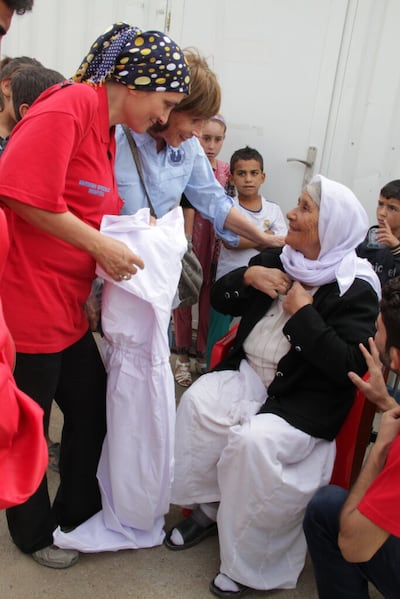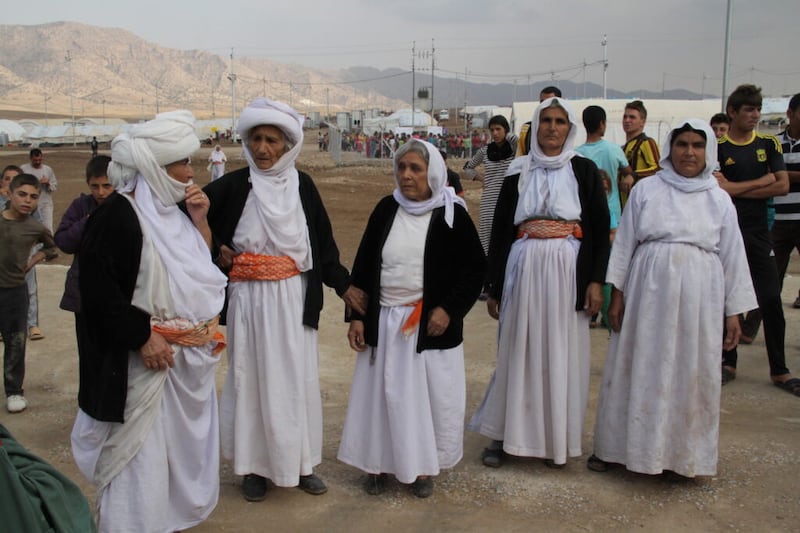Just as winter was approaching the Kurdish region of Iraq in 2014, I met several Yazidi women driven from their homes by the Islamic State of Iraq and Syria. With the other 16,000 displaced people in the camp I was visiting, the women were eating bread twice a day and had found shelter in one of the thousands of tents that dotted the landscape.
Yet, all their essential needs had not been met. They had been wearing the same long white dresses since arriving in the camp weeks earlier. As war and internal tensions and divisions polarized Iraq, they had no way to return home or buy or make new dresses.
Their situation was desperate.
They didn’t just need clean, warm clothing. They needed the white dresses that were part of their traditional attire and which carried significant cultural and religious meaning.
Wearing a hijab, the Muslim surgeon who ran the camp understood. So did the Latter-day Saint Charities volunteer — who dressed each day in sacred underclothing.
Three women of very different faith traditions were drawn together by their belief in God and a desire to follow him — one persecuted and needing help, the other two standing by her side.
A Yazidi woman wept when she was given a new white dress that symbolized her religious beliefs.

The scene was tender and powerful. It was also reflective.
As a faithful member of The Church of Jesus Christ of Latter-day Saints, I too wear religious clothing. My sacred temple garments are a constant reminder to me of promises I make as I worship in Latter-day Saint temples — to obey and serve, be morally pure and share my resources with others.
These promises connect me to Jesus Christ and help me feel close to him, his teachings and his love.
This week, my church released in the United States new designs for sacred Latter-day Saint underclothing — which covenant men and women in the church wear.
Women, particularly, are celebrating the greater flexibility offered by the new designs — lining up for hours at stores in the western United States to purchase them. Their release has also reignited conversations on social media and on other platforms about Latter-day Saint underclothing.
But this story is so much more than long lines of faithful members hoping to purchase the new garments.
Discussions about religious clothing are incomplete if they don’t include the covenants the clothing represents.
Like the Yazidi women in Iraq, the religious garments that I wear are less about how I dress and more about who I am.
Temple garments are a physical reminder of my commitment to follow Jesus Christ and the sacred promises that I have made with God. As I am faithful to these commitments, I receive blessings of mercy, protection, strength and power.
Though the designs of the temple garments have changed repeatedly over time, their purpose has remained constant.
Leaders of The Church of Jesus Christ have not commented on the newest revisions. This is not a surprise. Historically leaders have not issued statements or responded to press inquiries about temple garments or other issues related to the temple — where growth and understanding increase through participation as opposed to public discussion.
Still, it is tender to me, as a faithful Latter-day Saint woman, that the redesigned garment options were first available to men and women residing in hot, humid areas.
“Devout Latter-day Saints cherish the privilege of wearing the temple garment. Some of those members live in hot and humid areas,” said church spokesman Doug Andersen in a statement released one year ago. “The First Presidency has authorized changes in the garment to bless those members and others who might benefit from the changes.”
My previous work as a reporter and editor writing about The Church of Jesus Christ of Latter-day Saints has allowed me to associate with members in more than 40 nations. I have visited their homes and witnessed firsthand their unique challenges — which might include a lack of air conditioning and limited water or modern equipment to wash clothing.
Addressing the more than 17 million members of the church in about 170 nations last year, President Dallin H. Oaks spoke about garments and the temple, and about covenants and the responsibilities that come with them.
“Persons who wear their garments faithfully and keep their temple covenants continually affirm their role as disciples of the Lord Jesus Christ,” he said.
I witnessed this type of commitment from women of another faith in Iraq.
After ISIS drove the Yezidi women from their homes with little more than the clothes on their backs, they continued to wear their religious clothing — even when those white dresses became battered and soiled.
Their circumstances did not negate their commitments. Just as current styles of dress and trends for women’s clothing do not negate mine.
Photographs of that day in Iraq capture the sharing of white dresses.
But the real story wasn’t about what those women wore at all. It was all about who they were and what their commitments to God had made them.


